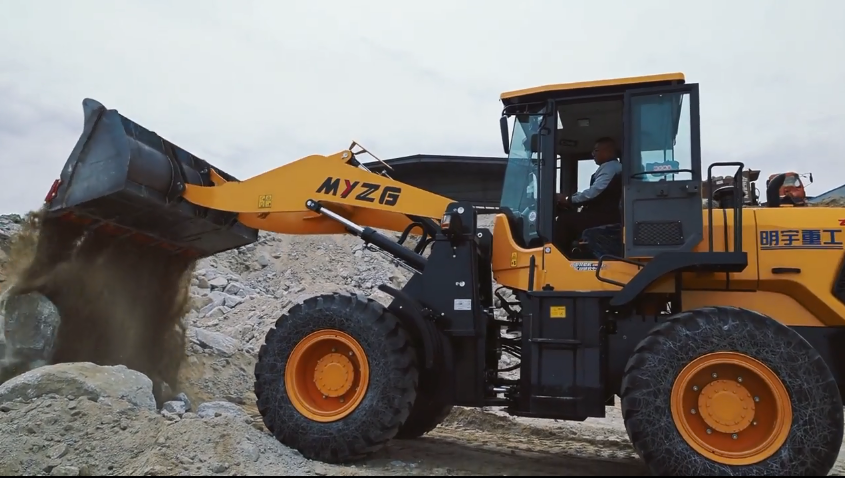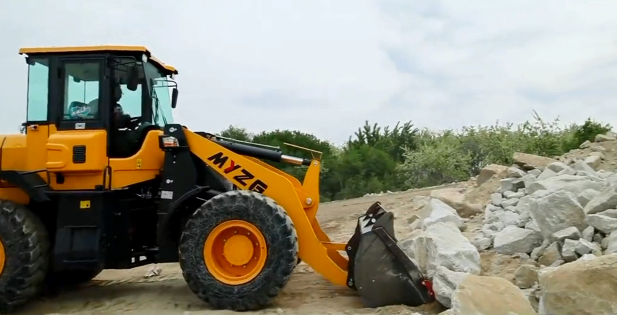Introduction
Wheel loaders, versatile heavy equipment, are indispensable in construction, mining, and agriculture. Their primary function involves loading and transporting materials, a task heavily reliant on their breakout force. This metric, often overlooked, is crucial in determining a wheel loader's efficiency and productivity.
Breakout force, in essence, is the maximum force exerted by a wheel loader's bucket to dislodge or break loose a pile of material. It's a measure of the machine's power and its ability to handle tough materials. A higher breakout force translates to quicker cycle times, increased productivity, and reduced operational costs.
This article delves into the intricacies of breakout force, examining its factors, measurement, and impact on wheel loader performance.

Understanding Breakout Force
The Mechanics of Breakout Force When a wheel loader's bucket digs into a material pile, several forces come into play:
- Hydraulic Force: The hydraulic system, powered by the engine, generates the force required to lift and curl the bucket.
- Mechanical Advantage: The bucket's design, especially its curvature and leverage points, amplifies the hydraulic force.
- Tire Traction: The tires provide the necessary traction to anchor the machine and prevent it from slipping.
The interplay of these forces determines the ultimate breakout force.
Factors Influencing Breakout Force
-
Bucket Design:
- Size: Larger buckets can handle larger loads, but they might compromise maneuverability.
- Shape: The curvature of the bucket's lip and sidewalls influences its ability to penetrate and retain material.
-
Hydraulic System:
- Pump Capacity: A high-capacity pump delivers more hydraulic fluid, increasing the force exerted by the cylinders.
- Flow Rate: The rate at which hydraulic fluid is delivered affects the speed of the bucket's movement.
- Pressure: Higher pressure translates to greater force.
-
Engine Power and Torque:
- A powerful engine provides the necessary energy to drive the hydraulic system and other components.
-
Tire Traction:
- Good tire traction ensures that the machine remains stable during digging and loading operations.
-
Ground Conditions:
- Soft ground can reduce traction and limit the breakout force.
-
Operator Skill:
- A skilled operator can maximize the machine's potential by using the correct techniques.
Measurement of Breakout Force
Direct Measurement
- Load Cells: These devices are installed between the hydraulic cylinders and the linkages to measure the force exerted.
- Strain Gauges: These sensors are attached to the bucket or frame to measure the stress and strain induced by the force.
Indirect Measurement
- Manufacturer's Specifications: Manufacturers often provide estimates of breakout force based on machine specifications and testing.
- Field Observations: Experienced operators can assess a machine's breakout force by observing its performance in various conditions.
Standardized Testing Procedures
- ASTM: The American Society for Testing and Materials provides standards for testing construction equipment, including wheel loaders.
- ISO: The International Organization for Standardization also has relevant standards.
Breakout Force and Wheel Loader Performance
A higher breakout force directly impacts a wheel loader's performance in several ways:
- Increased Material Handling Capacity: The machine can handle larger loads and tougher materials.
- Reduced Cycle Times: Faster loading and unloading cycles lead to higher productivity.
- Lower Fuel Consumption: Efficient operations reduce fuel consumption.
- Reduced Wear and Tear: Lower stress on components prolongs the machine's lifespan.
Case Studies
Construction Sites:
- Earthmoving: Wheel loaders with high breakout force are ideal for excavating large volumes of earth.
- Foundation Work: They can efficiently load and unload heavy construction materials.
Mining Operations:
- Ore Loading: High breakout force is essential for handling dense and abrasive materials like iron ore and coal.
- Overburden Removal: Removing layers of rock and soil requires powerful machines.
Agricultural Applications:
- Grain Handling: Efficiently loading and unloading grain from trucks and silos.
- Manure Management: Handling heavy and sticky materials.
Future Trends and Innovations
- Advanced Hydraulic Systems: More efficient and responsive systems will enhance breakout force.
- Electric and Hybrid Power: These technologies offer potential for increased power and torque.
- Intelligent Control Systems: Automated systems can optimize machine performance based on real-time data.
- Advanced Materials: Stronger and lighter materials can improve bucket durability and reduce weight.
Conclusion
Breakout force is a critical factor in determining a wheel loader's suitability for various tasks. By understanding the factors influencing breakout force and selecting the right machine for the job, operators can maximize productivity and efficiency. As technology continues to advance, we can expect even more powerful and versatile wheel loaders in the future.
Post time:Nov.07.2024

